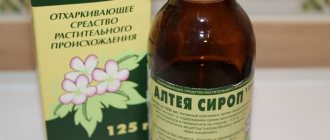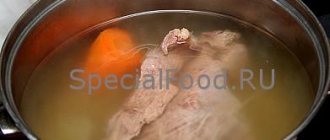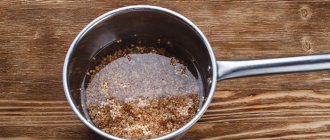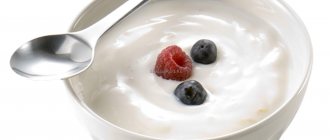Misconception:
What fruits can an 11-month-old baby eat? Can they be given in pieces or is it better to puree them? Many modern parents believe that it is better to give children under one year old fruit in pieces or drink juices with coarse pulp. Their opinion is explained by the fact that children are teething in the period up to eleven months, and the coarse fibers of the fruit massage the gums. This means that the process of growing the first teeth is less painful than for those children who do not eat pieces of fruit. Unfortunately, this fact has not been proven by scientific and medical works. On the contrary, almost all pediatricians advise mothers to feed their children not whole pieces of fruit, but fruit purees. Children whose teeth have not yet grown will not be able to chew and are at risk of choking.
Cook it yourself or buy it?
Caring and loving parents, wanting to give their child the best, will definitely say that the child should be fed only with their own pureed vegetables and fruits. The baby's parents claim that ready-made mixtures in a jar can hardly be called natural fruit or vegetable purees. Perhaps they are right. But there are nuances that parents often do not take into account when feeding their child.
It is advisable to give natural fruits and vegetables to your child only during their seasonal growth. Only natural fruits contain a lot of useful elements and vitamins that promote the growth of a child and strengthen his health. When buying fruit in winter, most mothers do not think about where and how they were grown. Therefore, you should not completely exclude purees from your child’s diet that are on the shelves of supermarkets and pharmacies. All fruits included in the canned puree are carefully sorted and selected before processing begins. The finished product is just as carefully monitored by health services before being bottled.
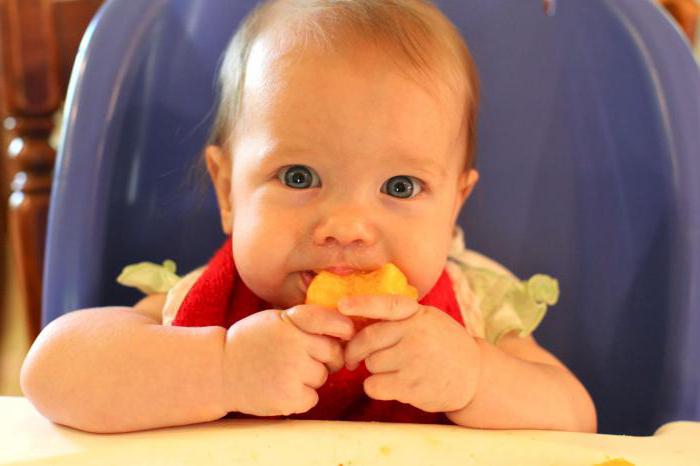
Useful qualities
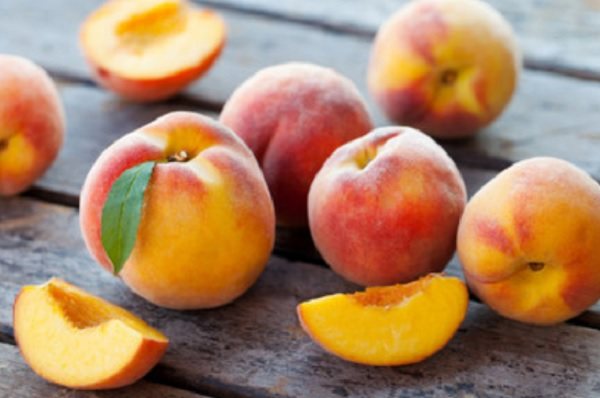
Every parent knows about the benefits of fruits and berries. What exactly is the value of peaches?
- The presence of valuable vitamins and mineral elements in the fruit promotes better formation of bones and internal organs, improves skin condition, and normalizes metabolic processes. In particular, vitamin E, beta-carotene, microelements magnesium, phosphorus, potassium, zinc, copper, and iron are responsible for this.
- Fiber, which is part of the peach, as well as pectins, have a beneficial effect on improving the functioning of the digestive system, prevent the formation of constipation, excessive accumulation of gases, colic, normalize the level of acidity in the stomach, and promote the removal of cholesterol and toxins from the body.
- The magnesium and potassium contained in the fruit have a beneficial effect on the functioning of the cardiovascular system.
- Iron, which is part of peach, helps normalize hemoglobin levels and prevents the development of anemia.
- The magnesium and zinc contained in the fruit have a beneficial effect on the nervous system.
- They influence the strengthening of the immune system and stimulate appetite.
- The organic acids contained in peaches have a beneficial effect on the harmonious development of the toddler. In particular, malic and citric acids help alkalize the body, rid the intestines of rotting products, valeric and caprylic acids add a strong aroma to the fruit, which, penetrating through receptors into the brain, has a relaxing effect on the body.
- Eating peaches during hot weather helps fight thirst and provides hydration to the body's cells.
Komarovsky's advice
What fruits can an 11 month old baby eat? Komarovsky says that you need to start feeding your baby gradually. You should not immediately switch to vegetable and fruit purees immediately after breast milk. Step-by-step actions are necessary in order to look at the reaction of the child’s body to new products from an unusual diet. To begin with, you should give a few spoons of fruit puree, and complete satiety should be achieved with the help of mother's milk or special infant formula. Every day, if there are no manifestations of allergic reactions on the child’s skin, you can add 1-2 teaspoons of fruit puree. It is worth looking at the general condition of the child’s body. The child should not eat with disgust, and the tummy should not swell after eating.
The doctor also says that you should not force food into your child that he does not like the taste of. A small organism itself knows what it needs at a certain stage of life. Komarovsky claims that it is precisely at the age of eleven months, when the child already has teeth, that he should be given fruit and vegetable decoctions, juices, and fruit and vegetable purees.
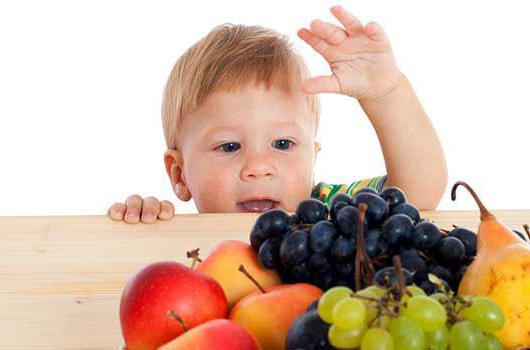
Input Features
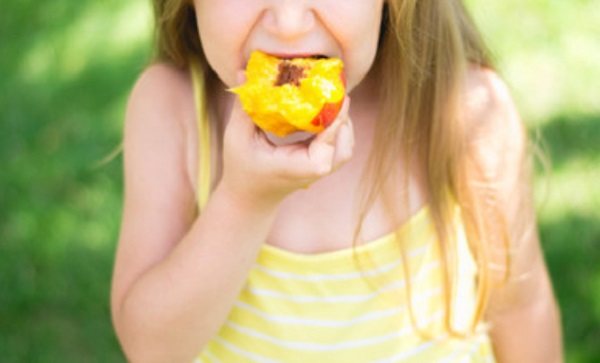
For baby food, choose only ripe peaches, first removing the peel.
When wondering whether children can eat peaches, you need to understand that any fruit can be in a child’s diet, but it must be introduced at a certain age, and this is important, since early introduction can lead to problems with the digestive system and cause an allergic reaction.
- First, let’s figure out at how many months you can introduce your baby to peach. It is important to consider what type of feeding the little one is on. For formula-fed babies, the optimal age is seven months; for babies fed breast milk, it is eight to nine months of age.
- For the first time, you shouldn’t give your baby a piece, much less a whole fruit. It is recommended to chop the peach into a fruit puree and offer your baby literally half a teaspoon. It is better to make the first acquaintance in the morning, so that there is enough time to monitor the body’s reaction to the introduction of a new product. You can give puree during one of the feedings, or between main meals.
- When introducing a new dish into a children's diet, it is unacceptable to introduce the little one to another new product. Otherwise, you will not know what exactly his body reacted to.
- If any undesirable consequences appear, and they can be manifested by an allergic reaction, in particular skin rashes, loose stools, bloating, severe anxiety, you should postpone your introduction to peaches for a while, preferably a month or two.
- If, after meeting the little one, redness, rash, runny nose or upset appear, and canceling the introduction of the peach did not improve the situation, then it is necessary to give the baby an antihistamine appropriate for his age and consult a doctor.
- If there are no negative manifestations, then next time you can try giving your baby a teaspoon of peach puree, then two, gradually increasing the single serving.
- After the child has fully adapted to the new fruit, it is important to consider that the daily dose of puree should be equal to the baby’s age (in months) multiplied by 10 (measured in grams). So, for example, a ten-month-old baby can be given one hundred grams of peach puree.
- To kid. Having reached the age of one, you can try giving the fruit in the form of cut pieces. It is recommended to give fresh peaches only if the baby has excellent digestion.
- If the toddler’s age allows him to start getting acquainted with peaches, and it’s a cold season outside, then you can use peach puree from baby food. It is only extremely important to ensure that the composition of the product is natural.
It is important to monitor how peaches intended for a child look. It is unacceptable to purchase fruits that have dents, signs of damage, mold, or rotten areas. It is also unacceptable to buy wrinkled or too soft fruits.
Where to begin?
What fruits can an 11 month old baby eat? It is better to start feeding your child fruit with simple fruits that are familiar to adults. These include: apples, pears, bananas, peaches, plums, apricots. You should only give your baby fruit in grated form, no more than two teaspoons per meal.
What fruits can an 11 month old baby eat? Can I have citrus fruits? At eleven months of age, you can feed your baby all types of citrus fruits, but it is worth checking the body’s reaction. Most children love tangerine and orange juices. Strawberries are also among the top foods most adored by children.
What other fruits can be given to a baby at 11 months? You can also grate the pulp of watermelon, dates and prunes. It is better to avoid exotic fruits such as pineapple, kiwi, papaya. You should start feeding your baby with them after eleven months, when all the main fruits become his usual diet.
Prohibited products for children under one year of age
The introduction of products into regular complementary foods also implies some restrictions. Although the desire of mothers and grandmothers to please the baby with a new taste is quite natural, you need to remember about the prohibitions of doctors. There are not very many of them, but a list of foods contraindicated for infants should always be kept at hand.

- Soda. Sweet carbonated water is harmful for both children and adults. However, many parents continue to buy illegal drinks for their children, not suspecting that bubbles of carbonic acid irritate the stomach, and phosphoric acid interferes with the absorption of calcium, as a result of which bones become brittle.
- Mushrooms. Prohibitions on “second meat” are quite justified, since fried or salted mushrooms are too heavy food for small children due to their excessively long digestion and absorption. Also, these objects of quiet hunting absorb a variety of toxins and other harmful substances.
- Sweets. Sugar-containing products - candies, chocolates, cakes and other sweet dishes - are prohibited foods. Sugar, palm oils and other substances can affect tooth enamel and the gastrointestinal tract. Cocoa is an allergenic product and should not be given to a child.
- Salty dishes. You need to introduce your baby to the natural taste of the dish, without any additives. Therefore, it is prohibited to add salt to food, and the baby should not eat salty foods - cucumbers, herring or various salted cookies.
- Sausages. An adult table is a temptation for a child, so parents often give their kids various sausages, forgetting that the prohibitions also apply to sausages. Their danger lies in their complex composition, which is oversaturated with spices and various dyes and taste improvers. Cheap varieties also contain transgenic fats.
- Fat meat. These varieties include lamb, duck and geese meat. Such products contain difficult-to-digest fats, which place excessive stress on the gastrointestinal tract. Eating these types of meat is fraught with digestive disorders.
- Potential allergens (vegetables and fruits). Scientists include brightly colored fruits and berries, usually red – peppers, apples, strawberries, and tomatoes. Also, tiny children are prohibited from eating citruses and other exotic fruits.
- Seafood. They contain proteins and vitamins that are extremely beneficial for the brain, but “sea dishes” often cause severe allergic reactions. Therefore, shrimp, oysters and mussels are prohibited from being given to small children.
- Store-bought seasonings. Various mayonnaises and tomato ketchups consist of a huge number of components, including harmful ones - additives, enhancers, etc. Most of them act as irritants, which may result in intestinal upset.
- Canned food. Canned fish products contain too much salt, preservatives and other chemicals, which are prohibited at an early age.
One product – one week
What fruits can a baby eat at 11 months and in what quantity? A child should be fed one fruit, such as a banana, for a week. After this time, you need to switch to another, for example orange. Every day, giving the child a certain fruit for a week, the mother can monitor the child’s tolerance to a certain product. If an eleven-month-old baby is fed different fruits every day, then in case of allergic reactions it will be very difficult to determine the allergen.
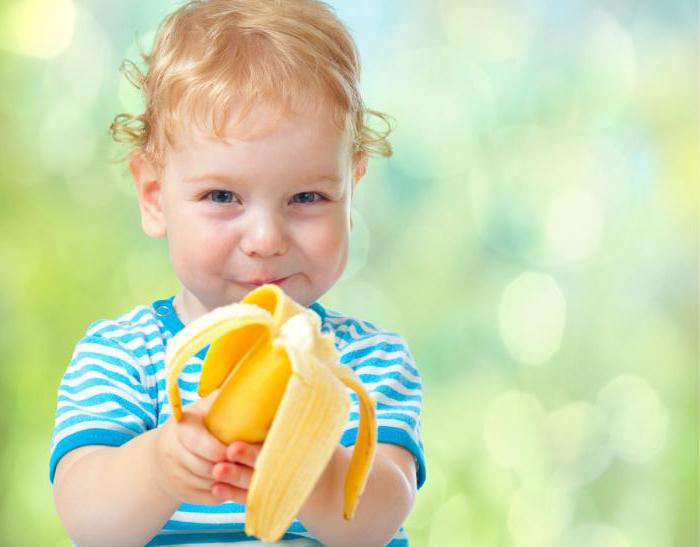
Peach serving options
Remember that the first acquaintance with a peach is the use of a puree mass; at the age of one, you can enjoy the fruit cut into pieces; older children can add a peach to baked goods.
Making peach puree
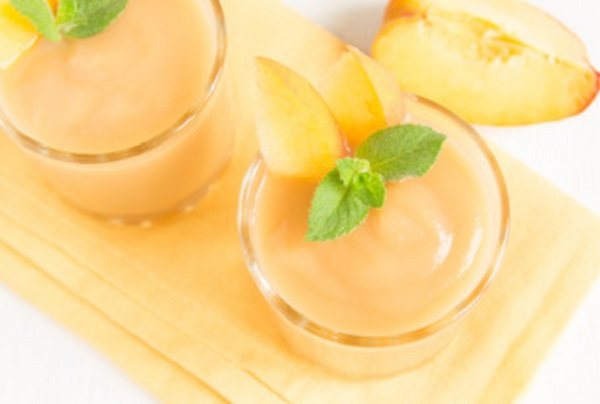
When preparing peach puree at home:
- wash the fruit thoroughly;
- lower it into boiling water for a few seconds;
- then cool under cold water;
- remove the peel;
- cut the fruit into slices, remembering to remove the pit;
- then grind using a blender;
- If the mass is too thick, you can add a little water intended for baby food. If you are cooking for a child who has been familiar with peaches for a long time, you can add homemade yogurt or baby cottage cheese to the puree.
Jelly
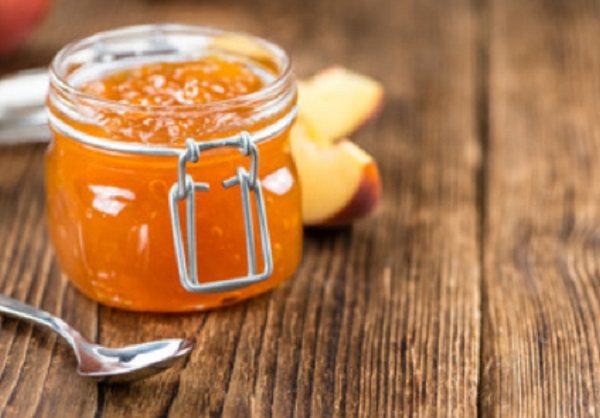
To prepare we will need:
- sugar - teaspoon;
- two medium-sized peaches;
- one and a half teaspoons of instant gelatin;
- a couple of drops of lemon juice;
- water - two hundred ml.
- Lightly boil the fruit and grind through a sieve.
- Add sugar and lemon juice to them.
- Boil for two minutes, then add pre-soaked gelatin.
- Bring the finished mixture to a boil, then remove from the stove and cool until it hardens.
Peach mousse
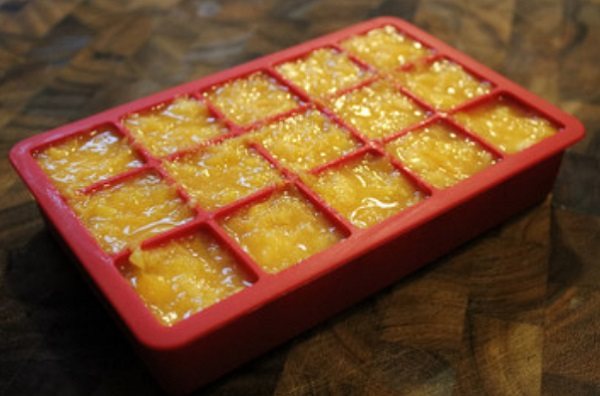
To prepare you will need:
- two or three peaches (depending on size);
- sugar - about 65 g;
- Art. spoon of lemon juice;
- gelatin - 10 g;
- cream - one glass.
- Wash the fruit thoroughly, dry it, and remove the pit.
- Cut into small slices and place the peaches in a container.
- Add sugar and grind with a blender.
- Grind the resulting mass through a sieve, add lemon juice.
- Take one tbsp. spoon of the prepared puree, add gelatin to it, heat over the fire. Make sure that the mixture does not boil (stir constantly).
- As soon as the gelatin begins to dissolve, transfer this mixture to the rest of the peach puree and mix everything thoroughly. Leave to cool.
- At this time, whip the cream. As soon as they thicken, add peach puree. Mix everything until smooth.
- We transfer the resulting mass into molds and wait for it to harden.
It is important to know when you can give your child a peach. Parents should understand that early introduction can lead to undesirable consequences, in particular to an allergic reaction, the same applies to excessive consumption of peaches. Remember that the first introduction should include a small portion of fruit, a new product should be introduced gradually, and only if there is no negative reaction from the child’s body, continue exploring the peach.
How to cook?
What fruits can a child eat at 11 months old and in what form? It is not advisable to give raw purees to small children who have not yet turned one year old, since the digestive system is not yet completely strong. In order to please your child with delicious fruits, they must first be baked or boiled if they involve cooking. All fruit porridges can be mixed with warm boiled water, but do not add sugar.
By following simple tips for feeding your children fruit, mothers will make their babies healthy and cheerful.
Cooking features
- Ripe but not overripe peaches are suitable for making puree. It is important that the fruits are not damaged, especially if you are preparing a dessert for a child.
- Before preparing the puree, the peaches must be peeled: if they get into the puree, it will make its taste rough. It is especially dangerous to leave peaches unpeeled if you plan to give the food to a baby. Small pieces of skin that get into the baby's esophagus can cause vomiting, which will keep the baby away from fruit supplements for a long time.
- It will not be difficult to remove the skin from peaches if you immerse them in boiling water for 1-2 minutes, then immediately transfer them to a container with cold water or, placing them in a colander, douse them in a cold shower.
- For small children and people watching their figure, it is advisable to prepare peach puree without adding sugar. First, the peaches are cut into pieces, stewed in a small amount of water, crushed in a blender, boiled again and placed in sterilized jars. The most careful housewives, before rolling up jars of puree cooked without sugar, sterilize them in boiling water - 2-3 minutes per 200 ml jar. It is advisable to do this if the product is intended for feeding a child.
- You can store puree prepared without adding sugar only in the cold: in a cellar or cold basement, or even better - in the refrigerator. Its shelf life, subject to storage conditions, will be 6 months. After opening the jar, its contents must be consumed within 24 hours; during this time, the puree can only be kept in the refrigerator.
- To store at room temperature, puree is made with added sugar. Typically, 0.25–0.5 kg of this sweet product is placed per kilogram of peaches. To balance the taste of the puree, citric acid or sour fruits are added to the composition. This also has a positive effect on the product’s resistance to unfavorable storage conditions.
- Jars for puree must be sterilized, otherwise it will quickly deteriorate. The jars are closed with metal lids to ensure a tight seal. These can be screw caps or key-tight ones - their configuration does not matter.
- The rolled up cans are turned over and covered with a blanket. Cooling in this form, they undergo additional preservation, which makes them stand better.
Peach puree can not only be canned, but also frozen. To do this, peach pulp, crushed to a puree, is laid out in the cells of a container for freezing ice and sent to the freezer. The frozen puree is removed from the mold and put into a bag, returned to the freezer. Peach puree prepared by freezing retains all its beneficial properties. There is only one drawback - you need to find a place for it in the freezer. Therefore, most housewives still prefer to make peach puree in jars for the winter.
How to make peach puree at home
We begin preparing the product by thoroughly washing the peaches and pouring boiling water over them. After 10 minutes, the boiling water must be drained. Peel the scalded peaches.
Divide the peeled fruits in half and remove the seeds.
Add 200 grams of water to the chopped peaches and place on low heat. Boil the mixture for about 20 minutes. If desired, you can add a little sugar, but if the puree is being prepared for an infant, then it is better to avoid sugar.
To make your puree soft and airy, it is preferable to use a blender. Boil the resulting puree over low heat for about 5 minutes.
In order for winter preparations to be stored for a long time, you need to thoroughly wash and. To sterilize jars at home, you just need to hold them over boiling water for about 5 minutes.
Fill the finished jars with peach puree and roll up the lids.
Our preparations for the winter are ready. It is best to store them in a cool place. By the way, peach puree prepared according to this old and simple recipe is devoured by both cheeks not only by children, but also by adults. In addition, it makes an excellent filling for homemade pies, buns and other baked goods.
Description
You can prepare peach puree for the winter, if only because it tastes very unusual and is completely different from the jam or marmalade we are used to. The dense concentration of fruit flavor in such a delicacy is literally amazing. What can such a blank be used for? Yes, literally for everything that your imagination can reach. This peach puree can be used to make an amazing sauce for meat. Any dessert will sparkle with new colors with the addition of this delicacy, not to mention the drinks that can be prepared from it. A detailed and simple recipe with step-by-step photos will tell you how to prepare such peach puree at home correctly and in accordance with all requirements. The freezing process does not have many subtleties, because we will cook without using additional ingredients. It is important to choose ripe, flavorful peaches for the puree so that they have a lasting tropical flavor. Containers for freezing must be used in special, small sizes; today they can be purchased at any store. Let's start preparing homemade peach puree for the winter.
Ingredients
How to choose fruits for making puree
Choose ripe fruits, even better than overripe ones. They should be soft when pressed. Rotten and unripe fruits are not suitable for this purpose. It would be ideal if the peaches are grown at home or purchased during the season from trusted sellers. There is a high chance that the fruit will be treated with chemicals if you buy it out of season. You will get much more harm from them than good. It is better to avoid such a purchase, or if you really want to, then do not give it to small children.
What products does a one-year-old baby need?
What can a baby eat? What foods are acceptable at his age? A child’s routine and nutrition should undergo changes from the age of 1. The baby's diet should be varied and balanced, especially during the period of active growth. Therefore, the question of what to feed a child after a year needs to be approached very seriously. Food and products offered to the baby must be healthy and meet the needs of the body.
Fruits and vegetables
It is already possible and even necessary to feed a one-year-old child fruits, berries and vegetables. All these products must be fresh and of high quality. It is best if you grow them yourself in your garden plot in the summer. In any case, try to purchase vegetables and fruits from a supplier or farmer you know.
It is best to give your baby berries, fruits and vegetables in season, giving preference to those grown in the area where you live. From 1 year you can eat greens.
Fresh fruits and vegetables should be present in the child’s diet in the form of purees or cut into small slices. The baby can eat them raw if the fruit or vegetables are soft enough.
You can also use them in processed form, for example, boiled or baked. It is best that half the norm of fruit is eaten fresh by the baby. As for vegetables, the proportion here may be less.
You need to be careful when your child consumes citrus fruits, since children are most often allergic to them. To avoid problems, it is better to postpone their introduction into complementary foods until a later time. Or try giving your baby a very small piece first and carefully observe the body’s reaction.
Cereal dishes
Porridge is an important element of a child's diet. Buckwheat and oatmeal are considered the most useful. A one-year-old child can also eat semolina, rice, millet, and corn porridge.
At the age of one year, it is better to give preference to special cereals made for babies in compliance with all standards. They are usually consumed for breakfast, half an hour or an hour after the baby wakes up.
Soups
You can also feed your child one year with soups and broths. First courses made with vegetable broth are very good and healthy. They are easy and simple to prepare, and the benefits are incredible. In addition, try to diversify your diet with puree soups. This type of soup is most loved by kids who are not yet familiar with chunky food.
Beverages
The child can drink juices, compotes, herbal teas after meals. Don't forget about clean drinking water; no other drinks can replace it. The water can be boiled or thoroughly purified. Boiled water can be given to your baby as needed in unlimited quantities.
Other products
It is not recommended for your child to eat any industrially produced sweets. The most acceptable option from the sweet menu is considered to be honey, molasses, natural syrups and dried fruits. It is better to replace sugar with fructose. It is better to use sweet fruits to sweeten porridge.
Adding salt to dishes is also undesirable. The permissible norm for a one-year-old toddler is 1 gram per day.
From the age of one year, a child can be introduced to bread products. You should give preference to wheat bread, but wait with rye bread for now, as it can cause fermentation processes in the intestines.






